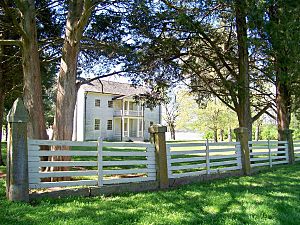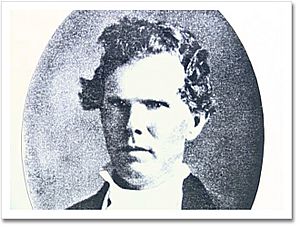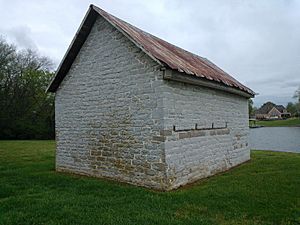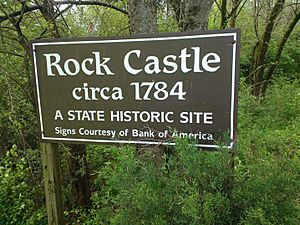Rock Castle (Hendersonville, Tennessee) facts for kids
Quick facts for kids |
|
|
Rock Castle
|
|
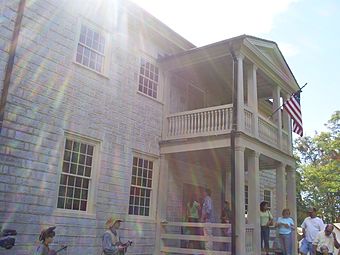 |
|
| Location | SE of Hendersonville on Indian Lake Rd 139 Rock Castle Lane, Hendersonville, TN 37075-4522, USA |
|---|---|
| Nearest city | Hendersonville, Tennessee |
| NRHP reference No. | 70000619 |
| Added to NRHP | July 8, 1970 |
Rock Castle State Historic Site is a fascinating old home located in Hendersonville, Tennessee, in Sumner County, Tennessee. It was once the home of an important historical figure named Daniel Smith (surveyor). Building the house started in 1784, but it took a while to finish because of conflicts with local Native American groups. The house was finally completed in 1796.
Today, Rock Castle is recognized as a National Historic Place and is open for everyone to visit. It's one of Tennessee's special historic sites, managed by the Friends of Rock Castle along with the Tennessee Historical Commission.
Contents
Meet Daniel Smith: A Pioneer and Leader
Daniel Smith was a very busy and important person in early American history. He was born in Virginia in 1748. As a young man, he studied medicine and surveying, which is the skill of measuring and mapping land.
Smith served as a captain in Lord Dunmore's War and later as a colonel in the American Revolution, helping America gain its independence. He also became a Brigadier General in the local militia. He helped create the U.S. Bill of Rights, which protects many of our freedoms today. He was also a Secretary of State for the territory and even a U.S. Senator.
Daniel Smith was known for his intelligence and honesty. He was praised by Thomas Jefferson, another famous American leader, for his good judgment and strong character.
Daniel Smith's Important Work
Smith played a big role in shaping the land that would become Tennessee. He was appointed to map out roads and even helped draw the border between Virginia and North Carolina. This line later became the boundary between Kentucky and Tennessee.
In 1790, President George Washington appointed Smith as the Secretary of the Territory South of the Ohio River. He also worked as an "Indian negotiator," which meant he helped make agreements with the Cherokee Indians in Tennessee.
Daniel Smith was also a talented mapmaker. He created maps of Tennessee and Kentucky. He is even credited with naming the state "Tennessee," after a Cherokee settlement. He helped write Tennessee's first state constitution and later served two terms as one of Tennessee's first Senators. He also surveyed the land for what would become Nashville, the state capital.
Daniel Smith's Family Life
In 1773, Daniel Smith married Sarah Michie. In 1783, he moved his family, including their two young children, to the area that is now Tennessee. He received this land from Virginia for his service in the Revolutionary War. They first lived in a small log cabin. However, local Native Americans sometimes caused conflicts, and their cabin was burned down.
Daniel Smith's good friend and neighbor was Andrew Jackson, who later became president. Smith even took over Jackson's Senate seat when Jackson resigned.
Sarah Michie Smith: A Strong Frontier Woman
Sarah Michie was born in 1755. Her father, William Michie, built the famous Michie Tavern in Virginia. Sarah grew up in a social environment, meeting important people like Thomas Jefferson and Patrick Henry. She met Daniel Smith through Dr. Thomas Walker, who introduced them. They married in 1773.
After marrying Daniel, Sarah moved to the frontier of Virginia. There, she gave birth to their two children, George and Mary Ann (nicknamed Polly). In 1783, the family moved to Sumner County, Tennessee. Life on the frontier was challenging and often dangerous due to potential conflicts with Native Americans.
Because of Daniel's many jobs, Sarah often found herself alone with her children. Her family described her as having "uncommon strength and courage with a strong sense of humor." She was a very outgoing and strong person.
Sarah also became close friends with Rachel Jackson, Andrew Jackson's wife. Rachel was a private person, but she found comfort and friendship with Sarah, often visiting the Smith home.
George Smith: Inheriting the Home
George Smith was Daniel and Sarah's son, born in Virginia in 1775. He moved with his family to Sumner County when he was about eight years old. George eventually inherited Rock Castle. As an adult, he faced financial difficulties. His son, Harry, who was a surveyor and soldier like his grandfather, had to help George manage his debts to keep the family home.
Mary Anne "Polly" Smith Donelson Saunders: A Spirited Daughter
Polly was Daniel and Sarah's daughter, born in 1781. She grew up on the American frontier. When she was fifteen, her father wanted to send her to a boarding school in Philadelphia to become a proper young lady. However, Polly had fallen in love with Samuel Donelson, Rachel Jackson's brother and Andrew Jackson's law partner.
Polly's father didn't approve of the marriage. So, Andrew Jackson and Samuel Donelson helped Polly sneak out of her bedroom window using a ladder. They rode to the Jackson's home, where a minister was waiting, and Polly and Samuel got married right away. Daniel was very angry at first but welcomed Polly back into the family a year later after she had his first grandchild. Polly and Samuel had three sons.
Sadly, Samuel died of pneumonia ten years into their marriage. Polly later remarried James Saunders, who was also a widower. Together, they had many children. Polly and Samuel's three sons eventually left home due to difficulties with their stepfather. Her oldest son joined the military and passed away. Her two younger sons, Andrew Jackson Donelson and Daniel Smith Donelson, were adopted by Andrew and Rachel Jackson.
Enslaved People at Rock Castle
Records about the enslaved people at Rock Castle are limited, but some information exists. Two enslaved individuals, Easter and her husband Alfred, are mentioned. Easter worked in the house as a maid or nanny. Alfred was often called "Uncle Alfred" by the Smith family, a common practice between slaveholding families and the enslaved people who served them closely.
A story from 1910 tells of an unnamed enslaved man who worked as a foreman on the farm. He was taken from the site by Native Americans. Later, when Daniel Smith was a Senator, the man contacted him, asking for help to be freed from his captivity. Smith offered $900 to the Native people, and the man returned to Rock Castle.
More reliable records show that by 1860, the Smith family owned 98 enslaved people. In 1833, a document lists the sale of several enslaved individuals from George Smith to Harry Smith. These names include Isaac, Martin, Charles, Cheshire, Larkin, Ina, Toby, Wilson, David, Henry, Sarah, Rachel, Judy, Baty, Mitchel, Daniel, Jeffrey, Patricia, and Patricia's two children, Henrietta and Silva.
The Mansion and Its Grounds
In 1788, Daniel Smith acquired a large amount of land, about 4,722 acres, in Sumner County, Tennessee, near the Cumberland River. This was in addition to land he received from North Carolina for his service in the American Revolutionary War. Over time, some of this land was sold. Today, about 18 acres surround the mansion.
The mansion was built from rocks found right on the property. This stone construction led to the idea that the house was a fireproof "castle." The house was built in three main parts over ten to twelve years.
The first part was a three-story section with a kitchen, a bedroom, and an attic. Later, a second three-story addition was built, including a basement and a dining room. The fireplace mantle in this section is made from black-maple wood from the Rock Castle grounds. The third and final addition was added to the front of the house, making it more formal. This area includes Daniel Smith's office.
Rock Castle is an early example of Federal Style architecture in Tennessee. The house originally had nine rooms. Skilled enslaved workers helped build the stone walls using a special pattern called "Flemish bond," which required careful planning and math. The roof was likely made of pine shingles.
The grounds also featured an herb garden and a peach orchard. The Smiths were known for their peach brandy. Daniel Smith, with his medical training, might have grown plants like rosemary and mint in his gardens for medicinal purposes. The main crops grown on the plantation were wheat and cotton.
The Family Cemetery
More than fifty family members are buried in the small family cemetery on the property. The largest markers belong to Daniel and Sarah Michie Smith, and their son George Smith. Their graves are covered by large, table-like stone markers. Daniel Smith's marker is showing its age but can still be read. The cemetery is surrounded by a stone fence with an iron gate, built from the same type of stone as the mansion.
Rock Castle Museum
Inside the mansion, visitors can see four original items that belonged to the first Smith family: a sugar chest, a blanket chest, Senator Smith's desk, and the original land grant from North Carolina. The museum archives also hold one hundred of Daniel Smith's books. George Smith's sideboard and a grandfather clock from a later generation are also displayed.
The State of Tennessee owns the property and buildings of Rock Castle. The Tennessee Historical Commission helps fund the site and handles major repairs. The Friends of Rock Castle, Inc. owns all the historical artifacts inside.
The Friends of Rock Castle group was formed in 1969 when the mansion and grounds were sold to the state by a Smith family descendant. It's a point of pride that only Smith relatives have owned the house throughout its history.
Today, most rooms in the mansion are set up to show what life was like in the late 1700s and early 1800s. Visitors can explore all nine rooms of the house.
Images for kids




